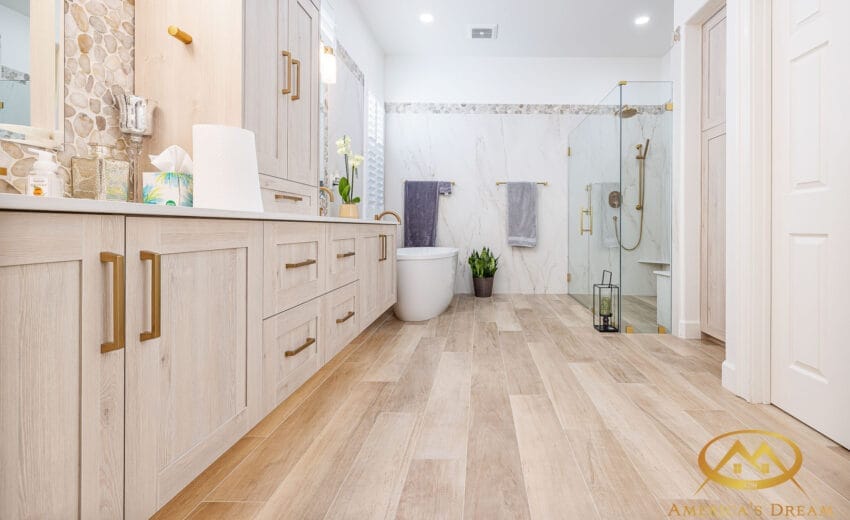In the realm of interior design and home improvement, flooring plays a pivotal role in defining the character and functionality of a space. Floating floors are increasingly becoming a preferred choice among homeowners, contractors, and designers for their practicality, affordability, and modern aesthetics. Whether you’re planning a renovation or a new build, floating floors present a compelling option that delivers on both form and function.
What Are Floating Floors?
A floating floor is a type of flooring that doesn’t require nails, staples, or glue for installation. Instead, the floorboards or tiles are designed to interlock or click together, “floating” over the subfloor. This innovative design allows for quick, hassle-free installation and makes floating floors an ideal solution for DIY enthusiasts and professional contractors alike.
Floating Floorboards
Floating floorboards are the individual planks or tiles that make up the floating floor system. Available in various materials like laminate, vinyl, and engineered wood, these floorboards are designed to provide durability, style, and ease of installation.
Why Choose Floating Floors?
1. Ease of Installation
Floating floors use a simple click-and-lock mechanism, eliminating the need for adhesives or nails. This method reduces labor costs and shortens installation time, making it an attractive option for homeowners.
2. Versatility
With a wide variety of materials, styles, and finishes, floating floors can complement any interior design—from modern minimalism to rustic charm.
3. Affordability
Floating floors are generally more budget-friendly compared to traditional flooring options like solid hardwood or stone. They offer a high-end look at a fraction of the price.
4. Durability
Floating floors are designed to withstand heavy foot traffic and everyday wear and tear. High-quality options like floating laminate flooring or engineered wood ensure long-lasting performance.
Floating Laminate Flooring: The Budget-Friendly Option
Laminate flooring is one of the most popular materials for floating floors. It replicates the appearance of natural wood or stone while being more cost-effective and low maintenance.
Advantages of Floating Laminate Flooring
- Affordable Aesthetic: Laminate offers the look of hardwood or tile at a significantly lower cost.
- Low Maintenance: Resistant to scratches, stains, and fading, laminate floors are easy to clean and maintain.
- Durability: Built with a strong wear layer, laminate can handle high-traffic areas like kitchens and living rooms.
Floating Wood Flooring: A Touch of Elegance
For those who desire the warmth and beauty of natural wood, floating wood flooring offers an excellent alternative to traditional hardwood.
Benefits of Floating Wood Flooring
- Authentic Appeal: Made from engineered wood or high-quality veneers, floating wood flooring brings genuine wood texture and character into your space.
- Eco-Friendly: Many floating wood floors use sustainably sourced materials, making them a greener choice.
- Ease of Installation: Like other floating floors, wood options click together without adhesives, simplifying the installation process.
Laminate Floating Floors: Combining Style and Functionality
Laminate floating floors blend the affordability of laminate with the convenience of floating installation. These floors are particularly well-suited for areas with uneven subfloors, as the underlayment helps level out minor imperfections.
Why Choose Laminate Floating Floors?
- Cost Efficiency: An economical choice for those seeking quality without a hefty price tag.
- Wide Design Options: Available in a variety of textures and colors, laminate floating floors can mimic wood, stone, or even tile.
- Resilience: With a wear-resistant surface, these floors are perfect for homes with pets, kids, or heavy foot traffic.
Check Our Recent Projects
Floating Floor Installation: A Step-by-Step Guide
One of the main attractions of floating floors is their straightforward installation process, which can often be completed without professional assistance.
Installation Steps:
- Prepare the Subfloor: Ensure it is clean, dry, and level. Use underlayment if needed for cushioning and soundproofing.
- Acclimate the Flooring: Allow the flooring materials to adjust to the room’s temperature and humidity for 48-72 hours before installation.
- Start Installation: Begin at one corner of the room, leaving a small expansion gap around the perimeter.
- Click and Lock: Align the boards and click them together securely.
- Trim and Finish: Use trim or molding to cover expansion gaps and complete the look.
Choosing the Right Floating Floor for Your Space
Whether you opt for laminate, vinyl, or wood, floating floors provide a practical and stylish solution for any home. Each material offers distinct advantages:
- Laminate: Affordable and easy to maintain, ideal for busy households.
- Vinyl: Water-resistant and versatile, perfect for bathrooms and kitchens.
- Engineered Wood: Elegant and durable, a premium choice for living areas.
Final Thoughts
Floating floors are revolutionizing the flooring industry with their innovative installation method, affordability, and design versatility. Whether you’re revamping a single room or your entire home, floating floors deliver beauty and durability without the complexity of traditional flooring methods.
If you’re ready to explore your flooring options, check out our collection of floating floors here. Let us help you find the perfect flooring solution to transform your space with ease and style!

















